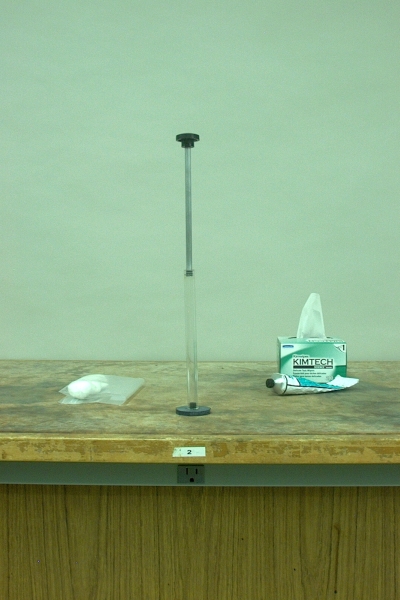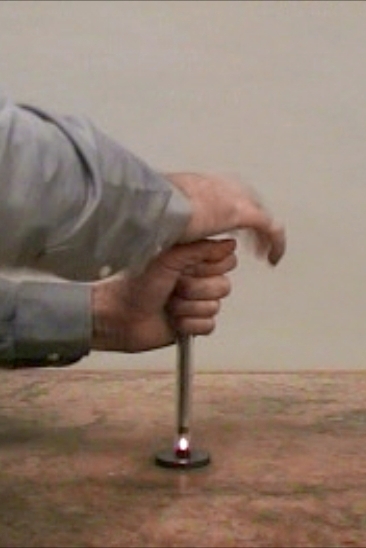 |
 |
Place a few wisps of cotton from a cotton ball, or a tiny shred of Kimwipe® on the platform of the rubber base. Place the acrylic tube over the platform, being careful not to disturb the cotton or paper. Insert the plunger into the open end of the tube, so that the top o-ring is seated just inside the end. While placing firm downward pressure on the tube with one hand to maintain a seal at the bottom of the tube, as quickly as you can, force the plunger down with your other hand. The sudden increase in pressure heats the air sufficiently to ignite the cotton or paper, as the photograph at right shows. Should the apparatus leak, you can use some silicone grease on the wall of the platform, and on the plunger o-rings, to improve the seal.
When you press down the plunger of this apparatus, you compress the gas inside the tube, raising the pressure inside the tube as you go. In doing so, you perform work on the gas, specifically what is usually referred to as “pressure-volume”, or “p-v” work. If you do this slowly, the heat you generate in doing this work can flow out of the gas into the wall of the tube, and the temperature remains (at least roughly) constant. The change in the internal energy of the gas (the system), ΔU, equals Q - W, where Q is the heat the enters the system, and W is the work done by the system on the surroundings. So you do work on the gas (W is negative, making -W positive), but heat can flow out of the system (so Q is negative), ΔU = 0, and thus the temperature, T, remains constant.
If, however, you press down on the piston very quickly, there is insufficient time for heat to flow out of the gas as you compress it; the process is said to be adiabatic. In this case, Q = 0. The work you do in compressing the gas, or most of it, adds to the internal energy of the gas, thus raising its temperature. Whereas for an isothermal compression or expansion (constant T), pV = a constant (Boyle’s Law), for an adiabatic compression or expansion, we must take into account the heat capacity ratio of the gas, γ, which equals Cp/Cv, the ratio of the heat capacity at constant pressure to the heat capacity at constant volume, and the equation becomes pVγ = a constant. For air, γ = 1.40. From this equation, we find p1V1γ = p2V2γ, and p2 = p1(V1/V2)γ. We can also find the relationship between temperature and volume, by means of the ideal gas law. Substituting for p in our first equation, we have (nRT/V)·Vγ = a constant, and TVγ-1 = a constant. Thus, T1V1γ-1 = T2V2γ-1, and T2 = T1(V1/V2)γ-1.
The piston in the fire syringe is longer than the cylinder, so the limiting factor in how much you can compress the air inside is how great a force you can exert on the piston. It is likely that you can achieve a compression ratio of about 15:1. (The height of the piston face above the base, when the apparatus is set up as shown above, is about 18 diameters (tube i.d.). If you force it down to about 1.2 diameters above the base, this corresponds to a compression ratio of 15:1.) For this compression ratio, or (V1/V2) = 15, the pressure at the bottom of your stroke is p2 = p1(15)γ, or (1 atm)(15)1.40 = 44.3 atm, and the temperature is T2 = (295 K)(15)0.40 = (295 K)(2.95) = 870 K, which is 600 °C, or about 1,100 °F – hot enough that you can ignite a small piece of cotton or paper, as shown in the photograph above on the right. Alternatively, once we have the pressure of the compressed gas, we could use the combined gas law (P1V1/T1 = P2V2/T2, which comes directly from the ideal gas law) to get T2 = T1(P2V2/P1V1), which gives T2 = 295 K (44.3 atm/[(1 atm)(15)]) = 295 K (2.95) = 870 K.
Adiabatic compression is the mechanism by which diesel engines operate. Such engines do not have a spark ignition, but instead rely on the heating caused by adiabatic compression to ignite the fuel-air mixture. This heating is also familiar to anyone who has used a bicycle pump to inflate bicycle tires (especially a frame pump). Though they are perhaps not common, it is also possible to find fire syringes that can be used to start fires. Such devices have a small cup in the face of the piston, into which one places a small piece of “char cloth.” One then quickly forces the piston into the cylinder, igniting the char cloth. One can then take the smoldering ember of char cloth, and transfer it to a small pile of kindling to start a fire. You can find an example here.
References:
1) Sears, Francis Weston and Zemansky, Mark W. College Physics, Third Edition (Reading, Massachusetts: Addison-Wesley Publishing Company, Inc., 1960) pp.349-366.